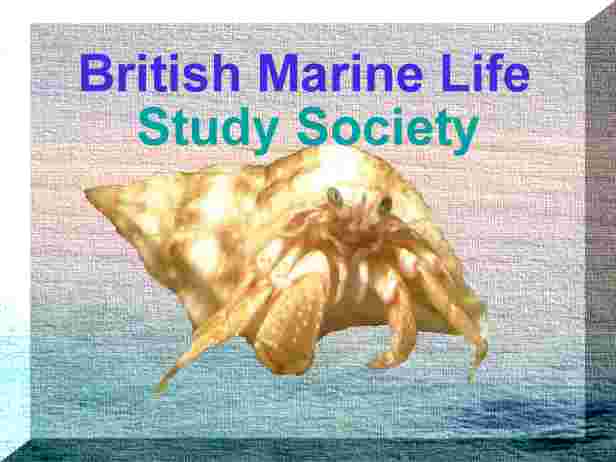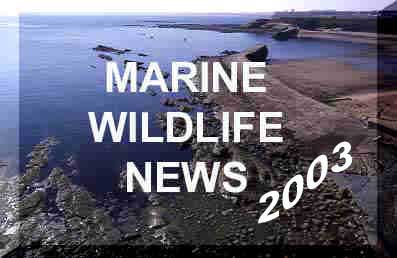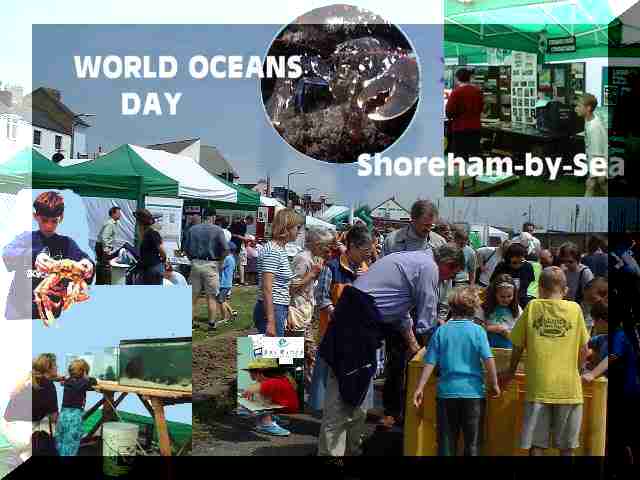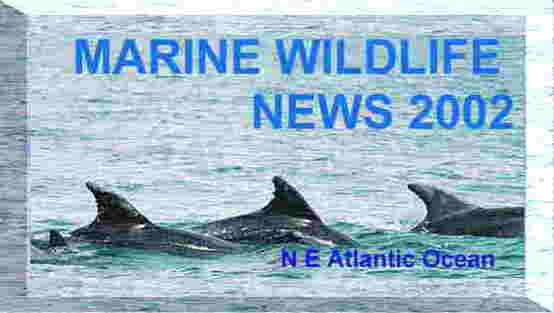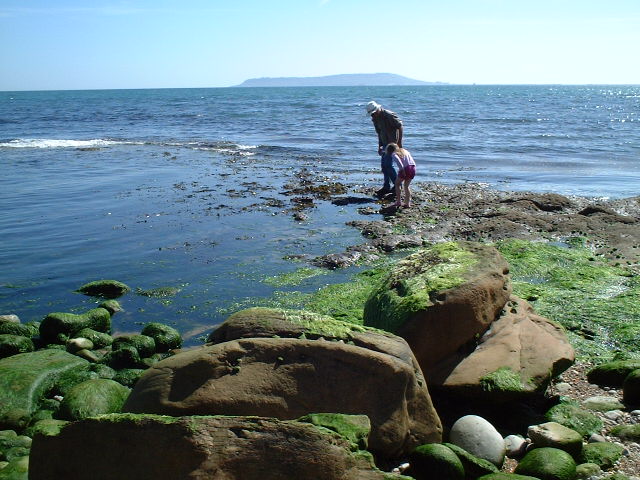-
|

Monthly
electronic news bulletin for the marine life of the NE Atlantic Oceans
including the seas around the British Isles.
The
bulletin is designed for Microsoft Explorer 4 and above using medium fonts
at a resolution of 800 x 600.
Subscribe
and unsubscribe options are at the foot of this page.
|
|
If
you receive this bulletin as an EMail subscriber, you may find the best
way to view the file is on your hard disc in your directory of Incoming
EMails.
|
| MARINE
LIFE NEWS
Reports
of marine wildlife from all around the British Isles, with pollution incidents
and conservation initiatives as they affect the flora and fauna of the
NE Atlantic Ocean.
-------------------------------------------------------------------------------------------------------------------------
 23
June 2003 23
June 2003
There
was a mass stranding of 500+ Mauve
Stingers (small jellyfish), Pelagia
noctiluca, at Porthcothan, Cornwall. This is the most unusual of
the British species of pelagic jellyfish to wash up, but large swarms occur
in years of abundance.
Despite
being a small jellyfish, it has a reputation as a stinger,
in the Mediterranean.
Amongst
the Sea Rocket, Orache etc, on the strandline, a Peanut
Plant has taken root.
Pelagia
Stings
Sea
Beans page
BMLSS
Jellyfish
22
June 2003

We
captured a large Lobster, Homarus gammarus,
off
a Portland (Dorset) wreck which weighed about 5 kg, but it only had one
claw. The human foot in the picture is size eleven. Specimens over 5 kg
are only occasionally caught incidentally in other fisheries as large lobsters
cannot get into the pots. They are often covered in keelworms.
BMLSS
Lobster Page
BMLSS
Crustacea
20
June 2003
David
Blackford reports an Ocean
Sunfish, Mola mola, in
St Ives Bay, Cornwall. It was about a metre long, and think it is
the first for the year.
BMLSS
Sunfish page
19
June 2003
15
June 2003
Whilst
netting the River Hayle, Cornwall, at low water for sandeel bait, the first
sweep brought a mixed bag of Greater Sandeels,
Hyperoplus
lanceolatus, and Lesser Sandeels, Ammodytes
tobianus, plus quite a few Lesser Weevers,
Echiichthys
vipera. The
unusual aspect was the large number of lice on the sandeel and free swimming
in the bunt. Whilst ejecting the Weevers we noticed one fish had two lice
stuck inside its mouth. My mate caught a louse and promptly let it go as
it bit him. They were about 8 mm long.

These
are isopods (wood-lice) and expert Tammy
Horton has confirmed that they are the parasitic species Ceratothoa
steindachneri. Sand-eel netters have reported
these isopods before.
Link
to Thumbnails
(Marine
Wildlife of the North-east Atlantic Ocean Group)
14
June 2003
A
jellyfish with a bell diameter of 45 cm and one metre long was spotted
off Shoreham-by-Sea, Sussex, at 7:00
pm. It was creamy white with a pink-blue rim
so it was almost certainly the Barrel Jellyfish,
Rhizostoma
octopus. These large jellyfish are
only occasionally encountered off the Sussex coast.
13
June 2003
We
have had four separate incidents of Sandeel
(family: Ammodytidae) mass mortality in
Ramsey Bay, Isle of Man (a lump of rock in the middle of the Irish Sea)
over the last two or three weeks. Two events co-incided with rising new
moon springs and the most recent with rising full moon springs. There were
no obvious causes and as with the events in other areas we can only speculate
on the cause. The main question is why only these small fish? The mortalities
were, not surprisingly, accompanied by frenzied gull activity.
A massive
bloom of plankton has turned the seas around the Shetland Isles a turquoise
colour, stretching at least 60 miles, almost the whole length of the islands,
from Yell the second most northern island to Sumburgh Head the southernmost
tip. The organism was the coccolithophore
Emiliania
huxleyi
which is responsible for vast
blooms covering up to 40 thousand square miles of the oceans and can be
seen from a space shuttle. Blooms this large can change the climate.
This plankton bloom is non-toxic not thought to pose a threat to the salmon
farms on the Shetlands.
News
Report
Reference
Book (see Chapter 6)
1999
Report of a bloom off Cornwall
c.
11 June 2003
On
the beach from Sutton-on-Sea up to Mablethorpe, East Lindsey (Easy Yorkshire),
we noticed thousands of dead starfish
ranging from 3-10 cm in size, along with large numbers of dead crabs and
some small shellfish. The starfish were almost certainly the Common
Starfish, Asterias rubens.
This stretch
of coast seems to be particularly prone to large and massive strandings
of starfish and other marine life.
Previous
Report of a Massive Wreck
Strandline
and Beachcombing Page
10-12
June 2003
Large
numbers of pelagic scyphozoan Pelagia noctiluca,
the Mauve Stinger
(small jellyfish), were spotted all along the east coast of Lundy, Bristol
Channel. I was participating in an English
Nature drop-down video survey and I found dense shoals of this beautiful
pelagic jellyfish. The density was probably in the region of 15 to 20 individuals
per square metre at the surface.
NB:
Swarms of this jellyfish are unusual in British seas.
Pelagia
Stings
BMLSS
Jellyfish page 2
7 June
2003
Hundreds
of the Blue Jellyfish, Cyanea
lamarckii, were seen whilst diving around the Lizard up to the
Helford river in Cornwall. Also seen in the Helford river was a Lion's
Mane Jellyfish, Cyanea
capillata, and a Compass Jellyfish,
Chrysaora
hysoscella.
The
staff at Porthkerris divers have recently seen vast numbers of By-the-Wind
Sailors,
Velella
velella, which turned the beach blue!
BMLSS
Jellyfish page 1
 6
June 2003 6
June 2003
Millions
(literally) of By-the-Wind Sailors,
Velella
velella, (a jellyfish-like animal) are being washed up alive to
perish on the shores of Cornwall, now reaching up the English Channel as
far east as Polperro and Looe. All
are very small, around 15 mm in length, and still have fleshy body parts
attached.
More
Cornish Reports
4 June
2003
I
was on Charmouth beach in Dorset doing a little fossil hunting and suddenly
found myself lying (best way to find tiny crinoids etc) in a wreck of tiny
jellyfish. They had a bizarre transparent float and were a vivid blue being
only around 25 to 30 mm long. These are By-the-Wind
Sailors,
Velella
velella.
Velella
page
Velella
Notes
MARLin
Velella
Web Page |

|
| PICTURE
GALLERY
Each
month, at least one special marine image will be published from images
sent to the BMLSS. This
can be of the seashore, undersea world or any aspect of the marine natural
world, especially the underwater life, but not restricted to life beneath
the waves. Topical inclusions may be included instead of the most meritorious,
and images will be limited to the NE Atlantic Ocean and adjoining seas,
marine and seashore species and land and seascapes.
A
very red Butterfish, Pholis gunnellus,
(photograph
and discussion)
Photograph
by Mike Noren
Question:
is this colour unusual for a breeding Butterfish?
More
photographs of Butterfish
-------------------------------------------------------------------------------------
Shore
Topography Series
The
name of the particular coast should be included and the grid reference,
if known. Print photographs can be included in Exhibitions
and on the BMLSS Web Sites and electronic publications. Electronic images
in *.JPG format can also be considered for the web site. They should not
exceed 150K in size.
Shore
Topography Portfolio
-----------------------------------------------------------------------------------------------------------------------------
The
rocky shore at Osmington Mills, Dorset, with Portland Island in the distance
Photograph
by Ray
Hamblett (Lancing Nature)
Click
on the image
for some more
on-line photographs
WEB SITES:
Osmington
Mills - Introduction: Geology of the Dorset Coast (part of the Jurassic
Coast
Overview
of the Jurassic Cliffs of Dorset
-----------------------------------------------------------------------------------
 Click
on the album for more links (On-line link) Click
on the album for more links (On-line link)

| WORLD
OCEANS DAY
In
June 1992, over 150 Heads of States signed the Convention on
Biological
Diversity at Rio de Janeiro. They did so to express a shared belief
that action must be taken to halt the worldwide loss of animal and plant
species and genetic resources.
World
Oceans Day was first declared as 8th June at the Earth Summit in Rio de
Janeiro in 1992.
Events
will occur all around the world on and around this day.
|
|
| DIARY
In
chronological order, the most recent events are at the top of the page.
Events open to the public, free or for a nominal charge only are included.
Most Seminars need to be booked in advance.
----------------------------------------------------------------------------------------------------------------------------
AUGUST
2003
PORCUPINE
FIELD MEETING - NORTHUMBERLAND
A
field meeting is planned for 28 August - 1
September 2003. A number of shores have recently
been investigated and the following have been chosen (we will do one shore
per day):-
Boulmer
[55o 25.0'N 01o
34.4'W; NGR 46/2614]
This
is a huge shore with extensive rock platforms and a sandy/muddy bay. There
is a wide variety of life.
Newton-by-the-Sea
[55o 31.0'N 01o
37.0'W; NGR 46/2425]
or
Beadnell [55o 37.4'N 01o;33.2'W;
NGR 46/2330]
Newton
has rock platforms and a sandy bay while Beadnell is rocky with gullies
and rock pools, with a sandy bay to the south. Newton
also has the best pub for lunch!
Lindisfarne
[55o 40.5'N 01o;48.0'W;
NGr 46/1342]
Cross
the tidal causeway (by car) and there is a variety of shores including
limestone rocks and a muddy/sandy bay. More walking required than for the
others so we'll hope for a particularly good day.
No
parking problems but loos not very evident.
Further
south near Cresswell there are interesting brackish lagoons.
We
can also have a day on Dove Marine Laboratory's boat "Bernicia"
for which Porcupine will underwrite some or all of the cost. However people
going on this trip may be expected to pay a small charge (no more than
£15).
The
tides are such that it would be most convenient to go on "Bernicia" on
Thursday 28 August,
although Monday 1 September
is a possibility.
It
would be helpful if you could decide quickly whether you are coming on
this excursion, because accommodation will have to be booked soon, as it
is still the holiday period. Alnwick is a suitable base area. Details of
accommodation can be provided from the Tourist Guide.
For
further information:
Please
contact the organiser: Shelagh Smith, Woodleigh, Townhead, Hayton, Brampton,
Cumbria, CA8 9JH:
Tel:
01228 670676 email: shelagh@smithurd.demon.co.uk
BIOSIS
Conference Calendar for Zoology
(Major
Link of all biological conferences around the world)
---------------------------------------------------------------------------------------------------------------------------------
Plymouth
Spring Talks Series
2003
No
talks are listed. Facilities are available for schools, linked to
the national curriculum.
All
talks are on Tuesdays and start at 7:00 p.m.
at
the National Marine Aquarium,
Coxside, Plymouth Devon.
Admission
– Adults £2.50; Children and NMA members £1.50, inclusive of
refreshments will be available.
Please
reserve your place by calling the Aquarium on 01752 275204
----------------------------------------------------------------------------------------------------------------------------
 SAMS
Seminar Series SAMS
Seminar Series
The Scottish
Association for Marine Science (SAMS)
Dunstaffnage Marine Laboratory, Dunbeg,
Oban, Argyll PA37 1QA
Tel: 01631 559000 Fax: 01631 559300
Email: mail@dml.ac.uk
For more details/how to find SAMS
see our website: http://www.sams.ac.uk
Unless otherwise stated, seminars
are held on Fridays at 4:15 pm
in the SAMS Conference Room
** Followed by the Friday R&R **
28
August 2003
SAMS exhibition in the
Heritage Centre at The Argyllshire Gathering in Oban.
9 -
12 September 2003
Second International
Symposium on Deep Sea Corals, 9 - 12 September, 2003, Erlangen, Germany.
For further details: www.cool-corals.de
Registration: cool-corals@pal.uni-erlangen.de
For more details
on the forthcoming talks, please contact Murray
Roberts (mailto:mr-t@dml.ac.uk)
or tel: 01631 559 000
----------------------------------------------------------------------------------------------------------------------------

A
series of monthly talks on marine conservation topics
These
talks are open to the public, admission is free.
3 July
2003
Marine
Life Talk at Southampton Oceanography Centre –
The
Shingle Currency – gravel, dredging and marine life off south east England
Sand
and gravel, in various combinations, cover most of the sea bed area of
South East England, forming an intricate mosaic of habitats. These habitats
are home to a diverse assemblage of animals, including rarities such as
the ross worm and commercially important species such as scallop and herring.
Sand
and gravel are also a vital resource for the construction industry and
are increasingly used in coast protection schemes. In the UK, over 4 tonnes
of sand and gravel are consumed per person per year. In London and the
South East, around a third of the sand and gravel demand is met from marine
sources. The industry is regulated by the Government and there are systems
in place to ensure that impacts on the environment are minimised.
But
is it really as simple as that? How important is the wildlife of sand and
gravel habitats? What effects does marine aggregate extraction have on
these habitats and species? Is the damage from dredging temporary or permanent?
And what are the Government, the aggregates industry and conservationists
doing to get a better understanding of the situation?
For
further information about The Wildlife Trusts’ marine work in South
England, including the events programme for South East Marine Week 2003,
please see www.southeastmarine.org.uk
or call Hampshire Wildlife Trust on 02380 688936.
To
find out more about the marine aggregate industry see www.bmapa.org or
contact the British Marine Aggregate Producers
Association on 0207 730 8194.
Lisa
Browning is Marine Conservation Officer for The Wildlife Trusts in
the South East. She is currently co-ordinating a major project entitled
‘Marine biodiversity and aggregates in South East England’. The project
is supported by English Nature, though Defra’s Aggregates Levy Sustainability
Fund.
Lisa
Browning has worked in marine conservation and environmental education
for the last nine years, including three years as Marine Ranger at Durlston
Country Park in Dorset, and a year freelancing as a marine education consultant
in Honduras and the UK.
Mark
Russell is Development Manager for the British Marine Aggregate Producers
Association, and has worked in the marine aggregate industry since 1995.
With
a background in marine geography and marine resource management, Mark’s
responsibilities during this time have encompassed the full range of production
and resource management issues associated with the industry, including
the development of new licences.
7 August
2003
Odessa
and the Black Sea – Ken Collins
4 September
2003
t.b.a.
2 October
2003
ROV
deep sea fish watching – Ian
Hudson
The
Marine Life Talks are held on the first Thursday of the month at 7.30 pm,
please arrive at 7.15 pm to be met in Reception. Southampton Oceanography
Centre is reached via Dock Gate 4 (between Town Quay and Ocean Village).
---------------------------------------------------------------------------------------------------------------------------- |
NEW
PUBLICATIONS & WEB PAGES
SHRIMPING FOR
FOOD AND FUN
 Local
shrimper Peter Talbot-Elsden, from Southwick (Sussex),
has produced a small booklet called “Shrimping for Food and Fun”
about catching the brown shrimp around the coasts of Britain. The shrimps
are caught in nets and the book features the various methods, firstly the
push-netting seen over the sand in shallow water in spring off the Sussex
coast. The famous Morecambe Bay shrimps were originally captured by cart
shanker shrimping with a horse and cart in deeper water off the Lancashire
coast, later replaced by a tractor. At Formby, they experimented with amphibious
vehicles after World War II. Nowadays, most commercial shrimping on the
east coast around King’s Lynn trawls from small boats using a net off the
stern. Shrimps are often cooked on board. Local
shrimper Peter Talbot-Elsden, from Southwick (Sussex),
has produced a small booklet called “Shrimping for Food and Fun”
about catching the brown shrimp around the coasts of Britain. The shrimps
are caught in nets and the book features the various methods, firstly the
push-netting seen over the sand in shallow water in spring off the Sussex
coast. The famous Morecambe Bay shrimps were originally captured by cart
shanker shrimping with a horse and cart in deeper water off the Lancashire
coast, later replaced by a tractor. At Formby, they experimented with amphibious
vehicles after World War II. Nowadays, most commercial shrimping on the
east coast around King’s Lynn trawls from small boats using a net off the
stern. Shrimps are often cooked on board.
The
28 page book contains 40 photographs of shrimping through the ages. It
is available through Bookworms of Shoreham
and other booksellers and museums at £3.50.
The
booklet is also available through the British
Marine Life Study Society, but at £4 including postage and packing.
--------------------------------------------------------------------------------------------------------------------
WEB
SITE
EurOcean
(European
centre for information on marine science and technology)
-------------------------------------------------------------------------------------------------------------------
PUBLICATIONS
Assessing
the sensitivity of seabed biotopes to human activities and natural events
MARLIN
(Marine Life Information Network)
+ MarLIN News
Issue 6 Spring 2003
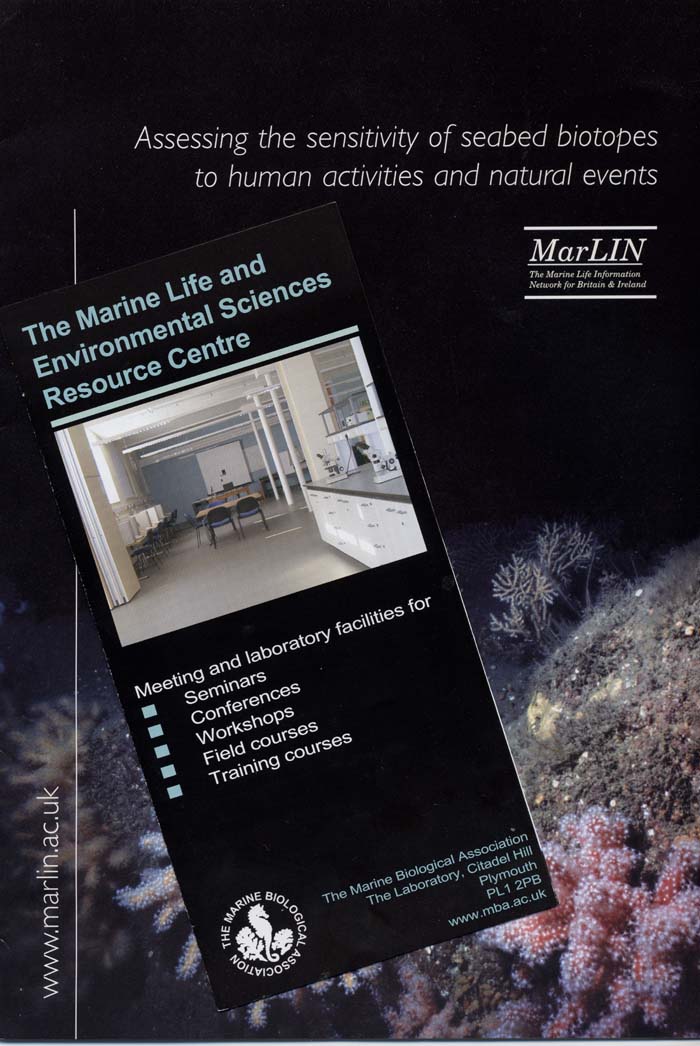
Sealife
Surveys: Identification Guide for Selected Underwater Species
 MarLIN
has published this new waterproof guide which is designed to support recording
projects. The 45 species in the guide have been selected for their ease
of recognition and their importance as species which play a key role in
maintaining particular communities, are likely to be affected by global
warming, or are non-native. The guide is produced in collaboration with
the Seasearch programme, which is a nationwide diving survey of underwater
habitats and species. Volunteers are taught about marine life, how to recognize
what's important and how to make records under water. MarLIN
has published this new waterproof guide which is designed to support recording
projects. The 45 species in the guide have been selected for their ease
of recognition and their importance as species which play a key role in
maintaining particular communities, are likely to be affected by global
warming, or are non-native. The guide is produced in collaboration with
the Seasearch programme, which is a nationwide diving survey of underwater
habitats and species. Volunteers are taught about marine life, how to recognize
what's important and how to make records under water.
You
can obtain a copy of the guide for £3 including post and packing
by sending a cheque to MarLIN, Marine Biological Association, Citadel Hill,
Plymouth PL1 2PB. Cheques are to be made payable to ‘Marine Biological
Association’. Copies are free to participants in organized surveys.
-------------------------------------------------------------------------------------------------------------------
RESOURCES
CENTRE
The
Marine Life and Environmental Sciences Resource Centre
The Marine Life
and Environmental Sciences Resource Centre
The
Marine Life and Environmental Sciences Resource Centre is based at the
historic Citadel Hill Laboratory of the Marine Biological Association on
Plymouth Hoe. The Association was founded to investigate life in the sea
and disseminate the knowledge gained for the public good.

The
Centre is designed for a variety of educational and training purposes in
support of the local, national and international community, including charities,
small and medium-sized businesses, schools and colleges, universities and
learned societies.
The
Centre provides a spacious and flexible venue combining facilities for
workshops, conferences and lectures with laboratory benching and equipment
for practical work and field courses. The Centre can be partitioned into
connecting meeting and laboratory areas or remain as one large space. The
following resources are available:
Seminar,
workshop and lecture facilities for up to 80 people
Fully
equipped laboratory holding up to 40 participants (inventory available
on request)
Seminar
area convertible into laboratory space giving one large lab. capable of
holding up to 80 students
Digital,
slide and overhead projectors
Networked
computing facilities
Display
and poster boards
Access
to the National Marine Biological Library
Seawater
systems
Boats
and sampling equipment
Easy
access to a wide range of marine habitats including estuaries, rocky and
sandy shores and open water
Close
proximity to local diving services
Catering
facilities for tea and coffee, buffets, formal lunches and dinners
Disabled
access and toilet facilities |
|
Marine
Biological Association of the U.K.
-------------------------------------------------------------------------------------------------------------------
| GREAT BRITISH MARINE ANIMALS |
by Peter Naylor |
published
by
Sound
Diving Publications |
ISBN 0
9522831 4 X |
| Available from |
 |

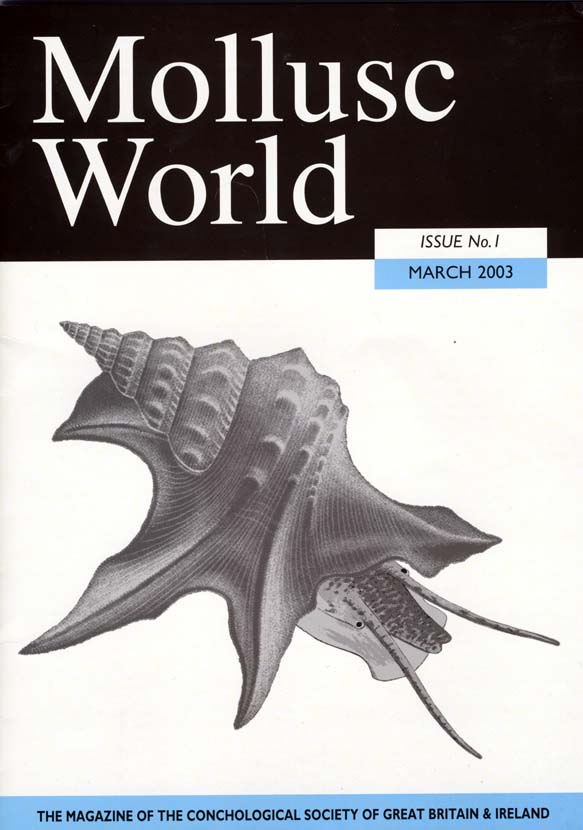
Published by the Conchological
Society
|
SOCIETY
INFORMATION
The
British Marine Life Study Society are responsible for producing the journal
GLAUCUS,
which is the first publication exploring the marine life of the seas surrounding
the British Isles available to the general public.
----------------------------------------------------------------------------------------------------------------------------
Change of EMail
Address
 Please
note that the EMail address for messages to the British Marine
Life Study Society has now changed Please
note that the EMail address for messages to the British Marine
Life Study Society has now changed
from
bmlss@compuserve.com
to Glaucus@hotmail.com
Messages
to the first address will not receive any guarantee of a reply and from
year 2003, the old EMail address is expected to fall into disuse.
----------------------------------------------------------------------------------------------------------------------------
Membership 2003
Current
members will
have their subscriptions waived for year 2003. An explanation was sent
before Christmas. This is because of he computer breakdown and the failure
of the full complement of paper publications.
|
|
Bulletin
Details
If
you receive this Bulletin direct from the British Marine Life Study Society
it will contain only hypertext and image (*.htm *.gif & *.jpg) files.
Recipients
can only unsubscribe if the Bulletin is received directly from the
BMLSS.
Permission
is granted to forward the Bulletin on unaltered. However, you will have
to include the images separately.
Subscribe/Unsubcribe
http://groups.yahoo.com/group/BMLSS-Torpedo
To
save download times, only new images are included with each Bulletin.
The
Bulletin is designed to be viewed on Internet Explorer using medium
fonts
at
a resolution of 800 x 600.
Viewing
should be possible on Netscape and other browsers.
|
|
Printing
the two column version of Torpedo (from issue 28)
These
pages are not designed for the default settings on the Page Set-ups of
your browser. I recommend viewing in Microscope Internet Explorer 6 and
altering the right and left hand columns in the Page Set-up menu to 9 mm
(from 19 mm).
The
page set-up can also be amended in Netscape Composer and other web page
editors, and this has the advantage of enabling the specified number of
pages to be printed and the information about the file (name, path, date)
to be deleted.
Some
of the images may not display if you have changed your directory for downloaded
files. The images may also not display properly if your settings on your
EMail software do not allow you do this automatically. When received in
Pegasus the format is changed slightly, but the bulletin is still readable.
|
---------------------------------------------------------------------------------------------------------------------------------
Compiled
on Netscape Composer 4.6 and other programs
|
